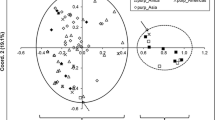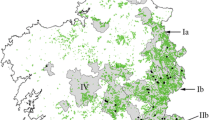Farmers’ Varietal Identification in a Reference Sample of Local Phaseolus Species in the Sierra Juárez, Oaxaca, Mexico. Farmer-named varieties are often the basis of in situ diversity assessment, collections for ex situ conservation, and on-farm improvement programs. Such varieties play an important role in sustainable agriculture because of their adaptation to local environmental conditions and consumer tastes. The importance of these varieties has stimulated interest in understanding farmers’ varietal classifications. We investigated the empirical basis of, and agreement among, farmers’ bean variety classification in a community in the Sierra Juárez, Oaxaca, Mexico. A reference sample of 300 local seeds of three Phaseolus species was sorted by nine farmers into named varieties. Nuclear and chloroplast microsatellite markers and seed morphology data were used to a) establish species identities; and test the hypotheses that b) farmer varieties reflect morphological and genetic structures; and c) there is agreement among farmers in variety classification. Because all farmers sorted the same set of seeds the variation in individual farmers’ classifications could be documented and compared. Our results indicate an empirical basis for farmer varieties, but without stringent classification rules. Varietal names underestimated diversity present at the community level because of the intravarietal variation present in farmer classifications. There was low classification agreement among farmers, although broad morphological and genetic patterns were present. The variation in farmers’ classifications of this Phaseolus diversity resulted in both synonymy and homonymy across classifications. The goal of farmers may not be to maintain the same variety across households, but to form a version of a broad type that best fits their own needs and circumstances at one point in space and time. Thus, in both work with farmers and collections of their Phaseolus varieties for ex situ conservation it should not be assumed that same-named seed lots are redundant units of diversity. Morphological and/or molecular data should, therefore, supplement farmer varietal names in assessments of in situ crop diversity, while ex situ collections would benefit from the inclusion of multiple accessions of the same variety from different farmers, repeated over time.
Identificación campesina de variedades en una muestra de referencia de especies locales de Phaseolus en la Sierra Juárez, Oaxaca, México. Los nombres locales de las variedades ofrecidos por los agricultores son, a menudo, la base para la determinación de diversidad in situ, las colecciones para la conservación ex situ, y para los programas de mejoramiento participativo. Tales variedades juegan un papel importante en la agricultura sostenible debido a su adaptación a las condiciones ambientales locales y los gustos de los consumidores. La importancia de estas variedades ha estimulado el interés en comprender los principios clasificatorios de los agricultores. Nosotros investigamos los principios empíricos y el grado de acuerdo sobre la clasificación de frijoles entre los agricultores de la Sierra Juárez, Oaxaca, México. Una muestra de referencia de 300 semillas locales de tres especies de Phaseolus fue clasificada por nueve agricultores en variedades con nombres locales. Morfología de las semillas y marcadores moleculares del núcleo y de lo cloroplasto fueron utilizados para: a) establecer las identidades de las especies; y para probar las hipótesis: b) que variedades identificadas por los campesinos reflejan estructuras morfológicas y genéticas; y c) que existe concordancia entre los agricultores en cuanto a la identificación de las variedades. Debido a que los agricultores clasificaron el mismo conjunto de semillas, la variación entre las clasificaciones de los agricultores como individuos pudo ser documentada y comparada. Nuestros resultados indican que hay una base empírica de la identificación campesina de las variedades, pero sin reglas clasificatorias estrictas. Los nombres de las variedades subestiman la diversidad existente en la comunidad debido a la inconsistencia presente entre las clasificaciones de los agricultores. Hubo un bajo grado de concordancia entre los agricultores, aunque pautas morfológicas y genéticas generales fueron presentes. La variación entre las clasificaciones campesinas de esta diversidad de Phaseolus resultó tanto en la sinonimia como homonimia entre las clasificaciones. Es posible que la meta de los agricultores no sea mantener la misma variedad de fijol entre granja y granja, sino de un tipo general formar una version que mejor responda a sus propios intereses y circunstancias en el espacio y el tiempo. Así, tanto en el trabajo con los agricultores y en la colección de sus variedades de Phaseolus para conservación ex situ, no debe asumirse que los lotes con el mismo nombre sean unidades redundantes de diversidad. Los datos morfológicos y/o moleculares deben, por consiguiente, complementar los nombres que proporcionan los agricultores en la determinación de la diversidad in situ, mientras que las colecciones ex situ podrían beneficiarse de la inclusión de accesiones múltiples de la misma variedad, pero de distintos agricultores, repetidas a lo largo del tiempo.




Similar content being viewed by others
Literature Cited
Barry, M. B., J. L. Pham, B. Courtois, C. Billot, and N. Ahmadi. 2007. Rice genetic diversity at farm and village levels and genetic structure of local varieties reveal need for in situ conservation. Genet Resour Crop Evol 54:1675–1690.
Berlin, B. 1992. Ethnobiological classification: principles of categorization of plants and animals in traditional societies. Princeton University Press, Princeton, New Jersey.
Blair, M. W., F. Pedraza, H. F. Buendia, E. Gaitan-Solis, S. E. Beebe, P. Gepts, and J. Tohme. 2003. Development of a genome-wide anchored microsatellite map for common bean (Phaseolus vulgaris L.). Theoretical and Applied Genetics 107:1362–1374.
Ceccarelli, S. 2012. Landraces: Importance and use in breeding and environmentally friendly agronomic systems. Pages 103–117 in N. Maxted, ed., Agrobiodiversity Conservation: Securing the Diversity of Crop Wild Relatives and Landraces. CABI Publishing, Oxfordshire, UK.
Escalante, A. M., G. Coello, L. E. Eguiarte, and D. Piñero. 1994. Genetic Structure and Mating Systems in Wild and Cultivated Populations of Phaseolus coccineus and P. vulgaris (Fabaceae). American Journal of Botany 81:1096–1103.
Evanno, G., S. Regnaut, and J. Goudet. 2005. Detecting the number of clusters of individuals using the software STRUCTURE: a simulation study. Molecular Ecology 14:2611–2620.
Fisher, D. G. and P. Hoffman. 1988. The adjusted Rand statistic: A SAS macro. Psychometrika 53:417–423.
Gaitan-Solis, E., M. C. Duque, K. J. Edwards, and J. Tohme. 2002. Microsatellite repeats in common bean (Phaseolus vulgaris): Isolation, characterization, and cross-species amplification in Phaseolus ssp. Crop Science 42:2128–2136.
González, R. J. 2001. Zapotec science: farming and food in the northern sierra of Oaxaca. University of Texas Press, Austin.
Hammer, K. and Y. Morimoto. 2011. Chapter 7: Classifications of infraspecific variation in crop plants. Pages 1–15 in L. Guarino, V. Ramanatha Rao, and E. Goldberg, eds., Collecting Plant Genetic Diversity: Technical Guidelines - 2011 Update. Bioversity International, Rome, Italy.
IAASTD (International assessment of agricultural knowledge, science and technology for development). 2009. Synthesis report with executive summary: a synthesis of the global and sub-global IAASTD reports. Washington, DC (http://www.agassessment.org/reports/IAASTD/EN/Agriculture%20at%20a%20Crossroads_Synthesis%20Report%20(English).pdf).
INEGI. 2011. Censo de Población y Vivienda 2010. Instituto Nacional de Estadística y Geografía, Mexico, D.F.
Jarvis, D. I., A. H. D. Brown, P. H. Cuong, L. Collado-Panduro, L. Latournerie-Moreno, S. Gyawali, T. Tanto, M. Sawadogo, I. Mar, M. Sadiki, N. T. N. Hue, L. Arias-Reyes, D. Balma, J. Bajracharya, F. Castillo, D. Rijal, L. Belqadi, R. Ranag, S. Saidi, J. Ouedraogo, R. Zangre, K. Rhrib, J. L. Chavez, D. Schoenu, B. Sthapit, P. De Santis, C. Fadda, and T. Hodgkin. 2008. A global perspective of the richness and evenness of traditional crop-variety diversity maintained by farming communities. Proceedings of the National Academy of Sciences of the United States of America 105:5326–5331.
Kwak, M., J. A. Kami, and P. Gepts. 2009. The putative Mesoamerican domestication center of Phaseolus vulgaris is located in the Lerma–Santiago Basin of Mexico. Crop Science 49:554–563.
Llaca, V., A. Delgado Salinas, and P. Gepts. 1994. Chloroplast DNA as an evolutionary marker in the Phaseolus vulgaris complex. Theoretical and Applied Genetics 88:646–652.
Peakall, R. and P. E. Smouse. 2006. GENALEX 6: genetic analysis in Excel. Population genetic software for teaching and research. Molecular Ecology Notes 6:288–295.
Pritchard, J., M. Stephens, and P. Donnelly. 2000. Inference of population structure using multilocus genotype data. Genetics 155:945–959.
Royal Horticultural Society. 2001. Royal Horticultural Society Colour Chart. Botanical color standards. Royal Horticultural Society, London, UK.
Sadiki, M., D. Jarvis, D. K. Rijal, J. Bajracharya, N. N. Hue, T. C. Camacho-Villa, and L. A. Burgos-May. 2006. Variety names: An entry point to crop genetic diversity and distribution in agroecosystems? in D. Jarvis, C. Padoch, and D. Cooper, eds., Managing Biodiversity in Agricultural Ecosystems. Columbia University Press, New York, NY.
SAS Institute, Inc. 2002–2011. SAS (Statistical Analysis System). Release 9.2. Cary, NC: SAS Institute, Inc.
Soleri, D. and D. A. Cleveland. 1993. Hopi crop diversity and change. Journal of Ethnobiology 13:203–231.
Steinley, D. 2004. Properties of the Hubert–Arabie Adjusted Rand Index. Psychological Methods 9:386–396.
von Borries, G.F. 2008. Partition clustering of high dimensional low sample size data based on p-values. Doctoral dissertation, Kansas State University, Manhattan, Kansas.
Weising, K. and R. C. Gardner. 1999. A set of conserved PCR primers for the analysis of simple sequence repeat polymorphisms in chloroplast genomes of dicotyledonous angiosperms. Genome 42:9–19.
Worthington, M., D. Soleri, F. Aragón-Cuevas, and P. Gepts. 2012. Genetic composition and spatial distribution of farmer-managed Phaseolus bean plantings: an example from a village in Oaxaca, Mexico. Crop Science 52:1721–1735.
Xu, D. H., J. Abe, J. Y. Gai, and Y. Shimamoto. 2002. Diversity of chloroplast DNA SSRs in wild and cultivated soybeans: evidence for multiple origins of cultivated soybean. Theoretical and Applied Genetics 105:645–653.
Yu, K., S. J. Park, V. Poysa, and P. Gepts. 2000. Integration of simple sequence repeat (SSR) markers into a molecular linkage map of common bean (Phaseolus vulgaris L.). Journal of Heredity 91:429–434.
Zent, S. (10). 1996. Behavioral orientations toward ethnobotanical quantification. Pages 199–239 in Alexiades, MN, ed. Selected guidelines for ethnobotanical research: a field manual. Bronx, NY: New York Botanical Garden.
Acknowledgements
We thank farming households and municipal authorities in Santa María Jaltianguis; thanks to Professor Eusebio Jiménez Nicolas for translation and correct notation of Zapotec bean variety names; for research assistance J.S. Muruaga-Martínez, Humberto Castro García, Laurentino Juárez Cruz; for advice and editorial comments S.R. Bowley, J. von Braun, D.A. Cleveland; for assistance in the molecular diversity analyses Estevan Quiroga. The suggestions of three anonymous reviewers greatly improved the manuscript. Financial support was provided by NSF (DEB-0409984) to DS, a University of California Mexico-US program (UC MEXUS) to PG, a UC Davis Jastro-Shields award to MW, and a UC Davis Department of Plant Sciences fellowship to MW.
Author information
Authors and Affiliations
Corresponding author
Additional information
Daniela Soleri and Margaret Worthington contributed equally.
Electronic supplementary material
Below is the link to the electronic supplementary material.
ESM 1
(DOCX 89.9 kb)
Rights and permissions
About this article
Cite this article
Soleri, D., Worthington, M., Aragón-Cuevas, F. et al. Farmers’ Varietal Identification in a Reference Sample of Local Phaseolus Species in the Sierra Juárez, Oaxaca, Mexico. Econ Bot 67, 283–298 (2013). https://doi.org/10.1007/s12231-013-9248-1
Received:
Accepted:
Published:
Issue Date:
DOI: https://doi.org/10.1007/s12231-013-9248-1




